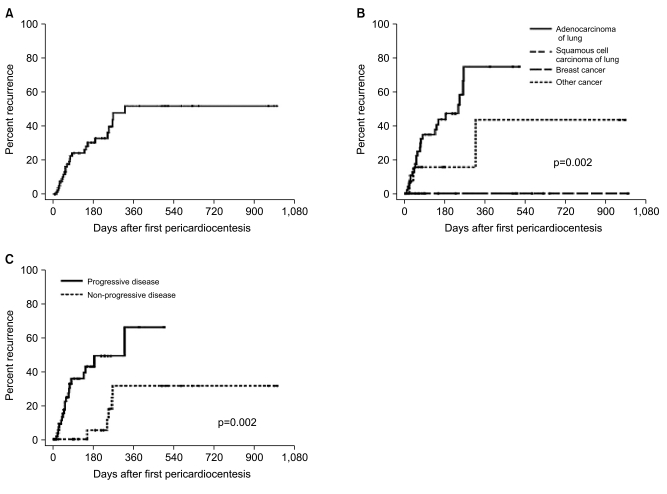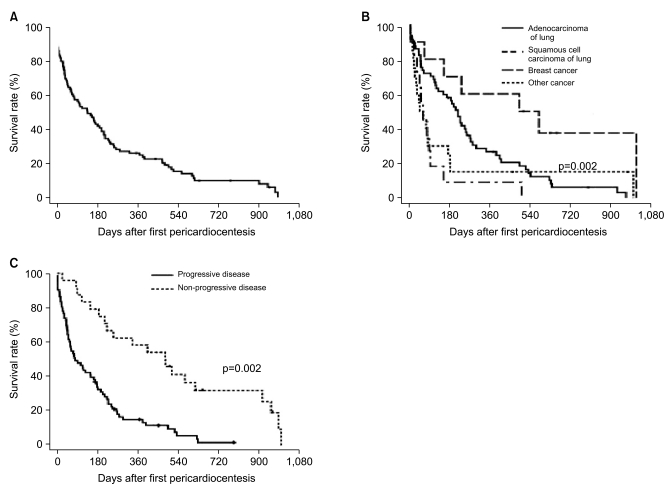Cancer Res Treat.
2010 Dec;42(4):210-216.
Clinical Characteristics of Malignant Pericardial Effusion Associated with Recurrence and Survival
- Affiliations
-
- 1Cardiology Clinic, National Cancer Center, Goyang, Korea.
- 2Cancer Biostatistics Branch, National Cancer Center, Goyang, Korea.
- 3Center for Lung Cancer, National Cancer Center, Goyang, Korea. jslee@ncc.re.kr
- 4Center for Breast Cancer, National Cancer Center, Goyang, Korea.
Abstract
- PURPOSE
We evaluated clinical outcomes after drainage for malignant pericardial effusion with imminent or overt tamponade.
MATERIALS AND METHODS
Between August 2001 and June 2007, 100 patients underwent pericardiocentesis for malignant pericardial effusion. Adequate follow-up information on the recurrence of pericardial effusion and survival status was available for 98 patients.
RESULTS
Recurrence of effusion occurred in 30 patients (31%), all of whom were diagnosed with adenocarcinoma. Multivariate analysis indicated that adenocarcinoma of the lung (hazard ratio [HR], 6.6; 95% confidence interval [CI], 1.9 to 22.3; p=0.003) and progressive disease despite chemotherapy (HR, 4.3; 95% CI, 1.6 to 12.0; p=0.005) were independent predictors of recurrence. Survival rates three months after pericardiocentesis differed significantly with the type of primary cancer; the rates were 73%, 18%, 90% and 30% in patients with adenocarcinoma of the lung, squamous cell carcinoma of the lung, breast cancer and other cancers, respectively.
CONCLUSION
Recurrence and survival of patients with malignant pericardial effusion are dependent on the type of primary cancer and response to chemotherapy. Patients with adenocarcinoma of the lung may be good candidates for surgical drainage to avoid repeated pericardiocentesis, but pericardiocentesis is considered effective as palliative management in patients with other cancers.
Keyword
MeSH Terms
Figure
Reference
-
2. Laham RJ, Cohen DJ, Kuntz RE, Baim DS, Lorell BH, Simons M. Pericardial effusion in patients with cancer: outcome with contemporary management strategies. Heart. 1996; 75:67–71. PMID: 8624876.
Article3. Tsang TS, Seward JB, Barnes ME, Bailey KR, Sinak LJ, Urban LH, et al. Outcomes of primary and secondary treatment of pericardial effusion in patients with malignancy. Mayo Clin Proc. 2000; 75:248–253. PMID: 10725950.
Article4. McDonald JM, Meyers BF, Guthrie TJ, Battafarano RJ, Cooper JD, Patterson GA. Comparison of open subxiphoid pericardial drainage with percutaneous catheter drainage for symptomatic pericardial effusion. Ann Thorac Surg. 2003; 76:811–815. PMID: 12963206.
Article5. Cullinane CA, Paz IB, Smith D, Carter N, Grannis FW Jr. Prognostic factors in the surgical management of pericardial effusion in the patient with concurrent malignancy. Chest. 2004; 125:1328–1334. PMID: 15078742.
Article6. Maisch B, Ristić AD, Pankuweit S, Neubauer A, Moll R. Neoplastic pericardial effusion. Efficacy and safety of intrapericardial treatment with cisplatin. Eur Heart J. 2002; 23:1625–1631. PMID: 12323163.
Article7. Dequanter D, Lothaire P, Berghmans T, Sculier JP. Severe pericardial effusion in patients with concurrent malignancy: a retrospective analysis of prognostic factors influencing survival. Ann Surg Oncol. 2008; 15:3268–3271. PMID: 18648881.
Article8. Gornik HL, Gerhard-Herman M, Beckman JA. Abnormal cytology predicts poor prognosis in cancer patients with pericardial effusion. J Clin Oncol. 2005; 23:5211–5216. PMID: 16051963.
Article9. García-Riego A, Cuinas C, Vilanova JJ. Malignant pericardial effusion. Acta Cytol. 2001; 45:561–566. PMID: 11480719.
Article10. Tsang TS, Enriquez-Sarano M, Freeman WK, Barnes ME, Sinak LJ, Gersh BJ, et al. Consecutive 1127 therapeutic echocardiographically guided pericardiocenteses: clinical profile, practice patterns, and outcomes spanning 21 years. Mayo Clin Proc. 2002; 77:429–436. PMID: 12004992.
Article11. Feigenbaum H, Armstrong WF, Ryan T. Echocardiography. 2005. 6th ed. Philadelphia: Lippincott Williams & Wilkins.12. Therasse P, Arbuck SG, Eisenhauer EA, Wanders J, Kaplan RS, Rubinstein L, et al. European Organization for Research and Treatment of Cancer. National Cancer Institute of the United States. National Cancer Institute of Canada. New guidelines to evaluate the response to treatment in solid tumors. J Natl Cancer Inst. 2000; 92:205–216. PMID: 10655437.
Article
- Full Text Links
- Actions
-
Cited
- CITED
-
- Close
- Share
- Similar articles
-
- Percutaneous Pericardiostomy and Trastuzumab Monotherapy for Treating Pericardial Metastasis from Breast Cancer and this Presented as Cardiac Tamponade
- Malignant pericardial effusion in carcinoma of the uterine cervix
- Pericardial effusion developed as Radiation-Induced heart disease(RIHD) in malignant lymphomas
- Two Cases of Primary HypoThyroidism Presenting with Pericardial Effusion
- Large Hypothyroidism-Induced Pericardial Effusion with Increased Serum Tumor Markers



